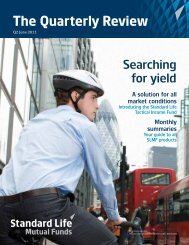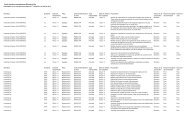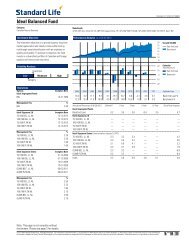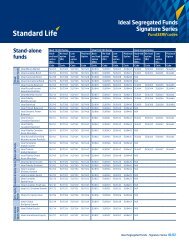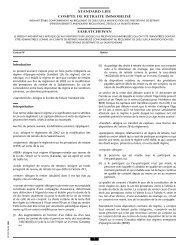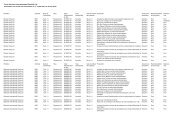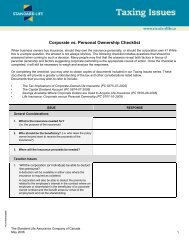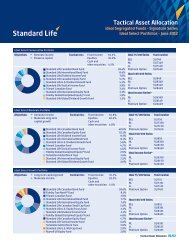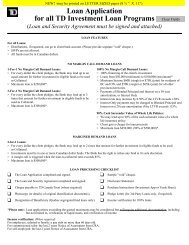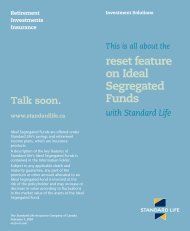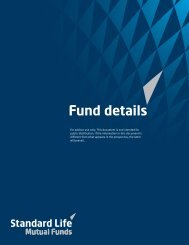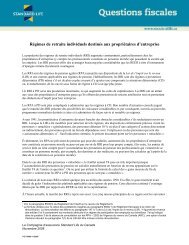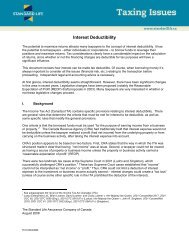Leveraged Supplementary Retirement Account - Standard Life
Leveraged Supplementary Retirement Account - Standard Life
Leveraged Supplementary Retirement Account - Standard Life
You also want an ePaper? Increase the reach of your titles
YUMPU automatically turns print PDFs into web optimized ePapers that Google loves.
Compounding effect of loan<br />
<strong>Leveraged</strong> <strong>Supplementary</strong> <strong>Retirement</strong> <strong>Account</strong><br />
Factors and risks to consider<br />
In a case where the interest is capitalized, the<br />
loan will increase each year by the amount of<br />
the interest. If the loan is in effect for a long<br />
period of time, the compounding effect of these<br />
additions may cause the loan amount to exceed<br />
the financial institution’s lending ratio based on<br />
the policy cash value and the financial institution<br />
may call the loan. Therefore, use of this loan<br />
arrangement should be restricted to applications<br />
where there is a natural limit to the likely<br />
duration of the loan. Use of the arrangement<br />
at retirement is ideal because life expectancy<br />
will tend to limit the loan duration. Since the<br />
ultimate intent is to repay the loan from the<br />
policy death benefit, the arrangement would not<br />
be appropriate if a person aged 40 or 50 were to<br />
start a series of loans today.<br />
Financial institution calls the loan<br />
If the loan were to exceed the maximum<br />
allowable percentage of the cash value, the<br />
financial institution could call the loan. If the<br />
financial institution recalls the loan, the life<br />
policy would be surrendered resulting in the loss<br />
of the tax-free death benefit and the triggering<br />
of tax on the accumulated gain. This possibility<br />
should be averted at all costs. It is especially<br />
important to note that any income tax liability<br />
arising out of a forced policy surrender is a<br />
liability for the policy owner, not the financial<br />
institution.<br />
The risk of the loan exceeding the cash<br />
value arises from three sources:<br />
1. An increase in the spread between the interest<br />
rate charged on the loan and the interest<br />
being earned within the policy.<br />
2. The time over which the loan is growing is<br />
longer than anticipated.<br />
3. The cost of insurance has a negative impact on<br />
the growth of the account.<br />
Investment risk<br />
There are risks associated with any type of<br />
investment. When debt is also incurred,<br />
additional factors must be considered. The<br />
maximum loan amount will depend on the<br />
investments held in the policy account. Financial<br />
institutions, currently, will generally loan up<br />
to 85% to 90% of the value of fixed income<br />
investments but only up to 50% to 60% of<br />
equity-linked investments. At the time of<br />
borrowing, the investment mix may need to<br />
be amended to maximize the amount that may<br />
be collateralized.<br />
Since the loan is generally a variable rate<br />
loan, the interest rate can increase without a<br />
corresponding increase in the return on the<br />
investments. Higher interest charges, if not paid<br />
yearly, can cause the outstanding loan balance<br />
to increase more rapidly and thus reducing<br />
future loan capacity. If the return on investments<br />
also drops, the fund and the maximum loan<br />
amount are also reduced. The outstanding loan<br />
and the policy account need to be monitored<br />
frequently to avoid a situation where the loan<br />
exceeds the financial institution’s ratio and<br />
forces a reduction in the loan through capital<br />
repayments or a collapse of the life policy to<br />
repay the debt.<br />
Changes in financial institution policy<br />
or tax rules<br />
Currently financial institutions make no<br />
commitment that they will continue to offer<br />
these types of loans in the future. Lending rules<br />
can change and may make this type of loan<br />
unavailable. As well, upon renewal, the financial<br />
institution may wish to change the terms of<br />
the loan. In addition, should the treatment<br />
of these loans by the tax authorities change,<br />
this arrangement could be rendered much<br />
less attractive.<br />
<strong>Standard</strong> <strong>Life</strong> 9



